Climate Change Complexity: Survey, Analysis and Recommendations Report
VerifiedAdded on 2023/01/17
|14
|2015
|99
Report
AI Summary
This report delves into the multifaceted complexities of climate change, examining its temporal, directional, structural, and technical dimensions. It explores key indicators such as project objectives, demand for coordination, stakeholder involvement, leadership, innovation, resources, and organizational relations. The report applies Ashby's law to understand the varieties leading to climate change and presents survey questions and interview data assessing stakeholder perspectives. Analysis of survey responses reveals insights into the perceived importance of various climate change indicators, with resources and leadership identified as critical factors. The report concludes by emphasizing the urgent need for cooperation and immediate action to address the global crisis posed by climate change, drawing upon the provided references to support its findings. The report highlights the interconnectedness of climate change with various sectors and the need for a comprehensive approach to tackle this global challenge.
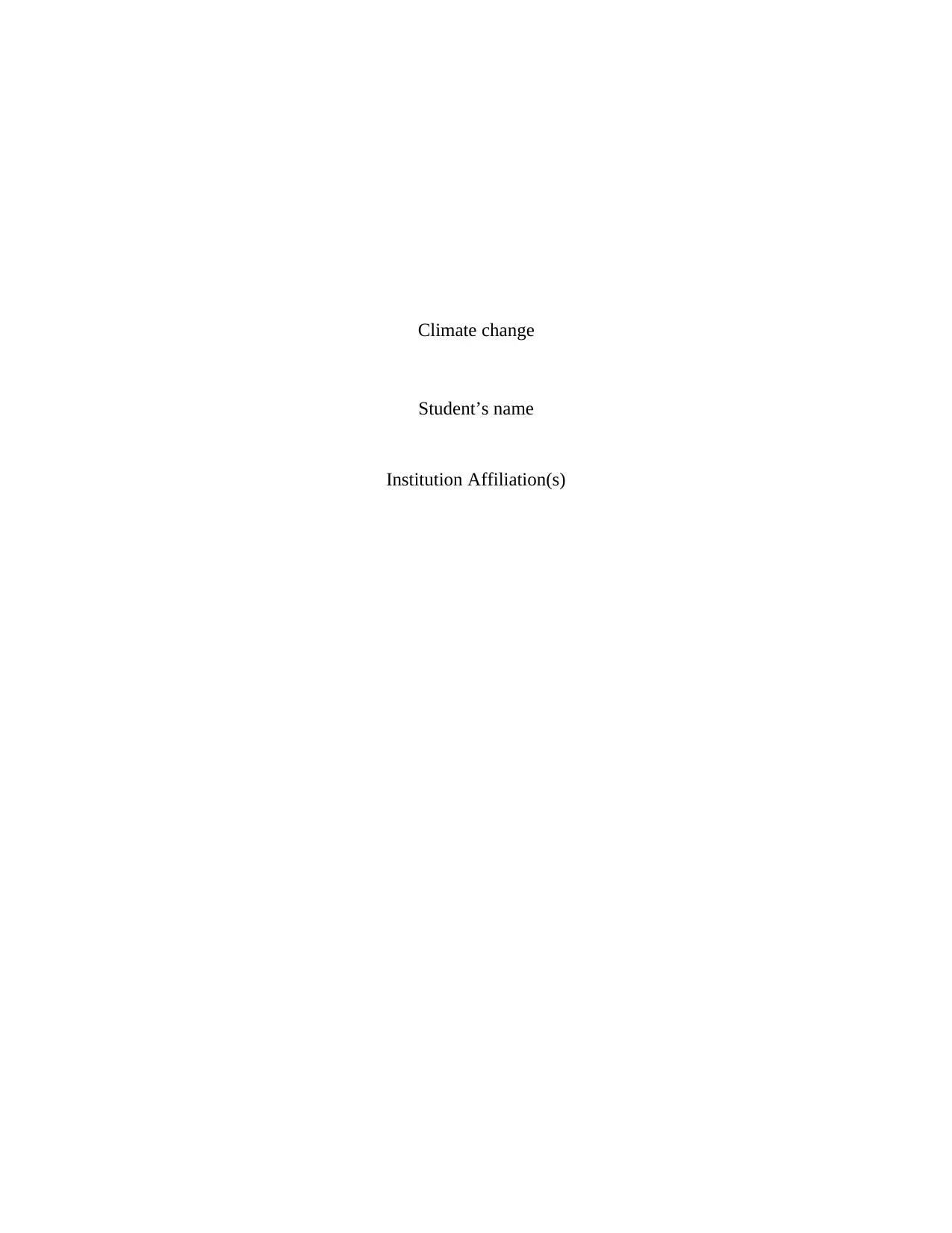
Climate change
Student’s name
Institution Affiliation(s)
Student’s name
Institution Affiliation(s)
Paraphrase This Document
Need a fresh take? Get an instant paraphrase of this document with our AI Paraphraser
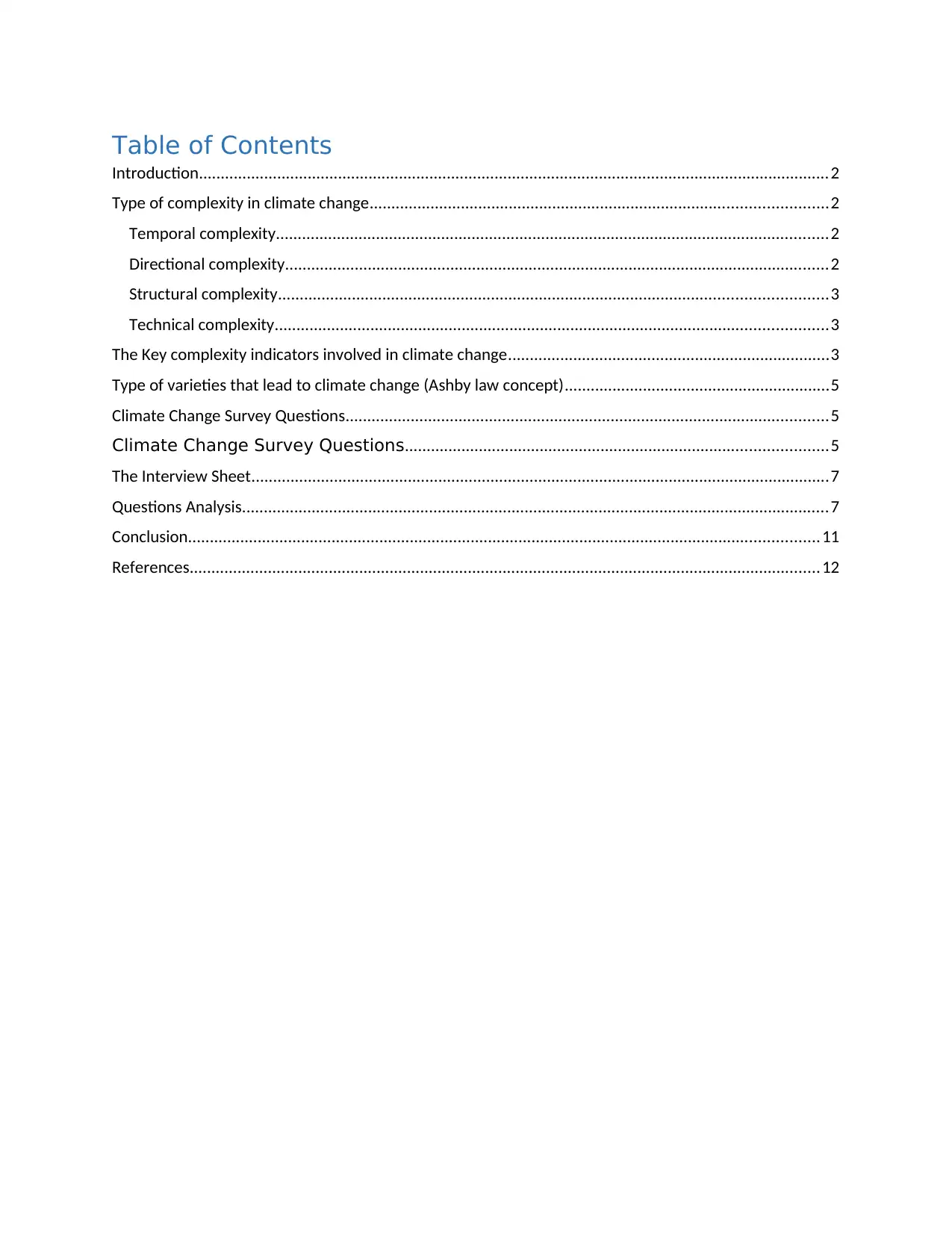
Table of Contents
Introduction.................................................................................................................................................2
Type of complexity in climate change.........................................................................................................2
Temporal complexity...............................................................................................................................2
Directional complexity.............................................................................................................................2
Structural complexity..............................................................................................................................3
Technical complexity...............................................................................................................................3
The Key complexity indicators involved in climate change..........................................................................3
Type of varieties that lead to climate change (Ashby law concept).............................................................5
Climate Change Survey Questions...............................................................................................................5
Climate Change Survey Questions.................................................................................................5
The Interview Sheet.....................................................................................................................................7
Questions Analysis.......................................................................................................................................7
Conclusion.................................................................................................................................................11
References.................................................................................................................................................12
Introduction.................................................................................................................................................2
Type of complexity in climate change.........................................................................................................2
Temporal complexity...............................................................................................................................2
Directional complexity.............................................................................................................................2
Structural complexity..............................................................................................................................3
Technical complexity...............................................................................................................................3
The Key complexity indicators involved in climate change..........................................................................3
Type of varieties that lead to climate change (Ashby law concept).............................................................5
Climate Change Survey Questions...............................................................................................................5
Climate Change Survey Questions.................................................................................................5
The Interview Sheet.....................................................................................................................................7
Questions Analysis.......................................................................................................................................7
Conclusion.................................................................................................................................................11
References.................................................................................................................................................12
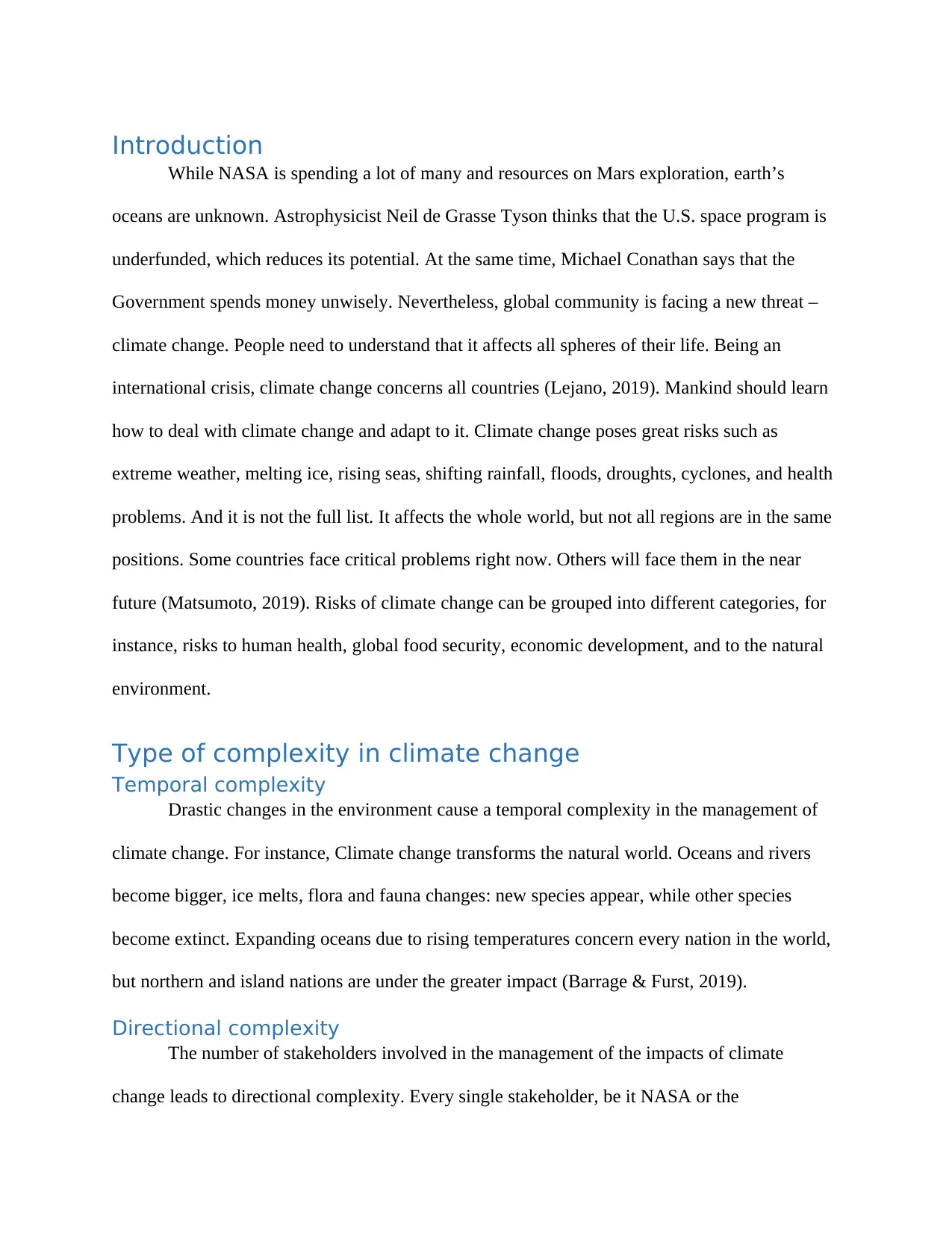
Introduction
While NASA is spending a lot of many and resources on Mars exploration, earth’s
oceans are unknown. Astrophysicist Neil de Grasse Tyson thinks that the U.S. space program is
underfunded, which reduces its potential. At the same time, Michael Conathan says that the
Government spends money unwisely. Nevertheless, global community is facing a new threat –
climate change. People need to understand that it affects all spheres of their life. Being an
international crisis, climate change concerns all countries (Lejano, 2019). Mankind should learn
how to deal with climate change and adapt to it. Climate change poses great risks such as
extreme weather, melting ice, rising seas, shifting rainfall, floods, droughts, cyclones, and health
problems. And it is not the full list. It affects the whole world, but not all regions are in the same
positions. Some countries face critical problems right now. Others will face them in the near
future (Matsumoto, 2019). Risks of climate change can be grouped into different categories, for
instance, risks to human health, global food security, economic development, and to the natural
environment.
Type of complexity in climate change
Temporal complexity
Drastic changes in the environment cause a temporal complexity in the management of
climate change. For instance, Climate change transforms the natural world. Oceans and rivers
become bigger, ice melts, flora and fauna changes: new species appear, while other species
become extinct. Expanding oceans due to rising temperatures concern every nation in the world,
but northern and island nations are under the greater impact (Barrage & Furst, 2019).
Directional complexity
The number of stakeholders involved in the management of the impacts of climate
change leads to directional complexity. Every single stakeholder, be it NASA or the
While NASA is spending a lot of many and resources on Mars exploration, earth’s
oceans are unknown. Astrophysicist Neil de Grasse Tyson thinks that the U.S. space program is
underfunded, which reduces its potential. At the same time, Michael Conathan says that the
Government spends money unwisely. Nevertheless, global community is facing a new threat –
climate change. People need to understand that it affects all spheres of their life. Being an
international crisis, climate change concerns all countries (Lejano, 2019). Mankind should learn
how to deal with climate change and adapt to it. Climate change poses great risks such as
extreme weather, melting ice, rising seas, shifting rainfall, floods, droughts, cyclones, and health
problems. And it is not the full list. It affects the whole world, but not all regions are in the same
positions. Some countries face critical problems right now. Others will face them in the near
future (Matsumoto, 2019). Risks of climate change can be grouped into different categories, for
instance, risks to human health, global food security, economic development, and to the natural
environment.
Type of complexity in climate change
Temporal complexity
Drastic changes in the environment cause a temporal complexity in the management of
climate change. For instance, Climate change transforms the natural world. Oceans and rivers
become bigger, ice melts, flora and fauna changes: new species appear, while other species
become extinct. Expanding oceans due to rising temperatures concern every nation in the world,
but northern and island nations are under the greater impact (Barrage & Furst, 2019).
Directional complexity
The number of stakeholders involved in the management of the impacts of climate
change leads to directional complexity. Every single stakeholder, be it NASA or the
⊘ This is a preview!⊘
Do you want full access?
Subscribe today to unlock all pages.

Trusted by 1+ million students worldwide
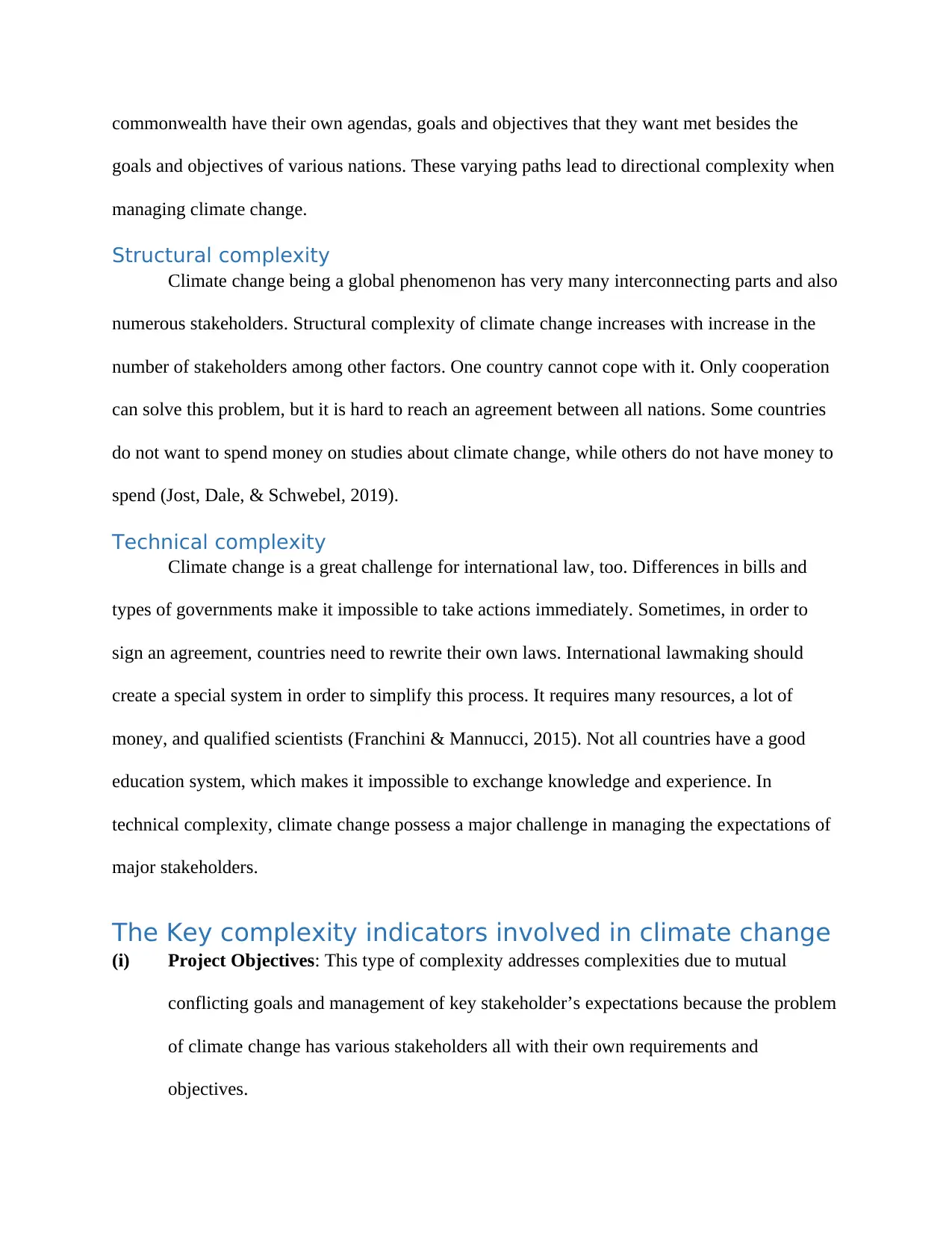
commonwealth have their own agendas, goals and objectives that they want met besides the
goals and objectives of various nations. These varying paths lead to directional complexity when
managing climate change.
Structural complexity
Climate change being a global phenomenon has very many interconnecting parts and also
numerous stakeholders. Structural complexity of climate change increases with increase in the
number of stakeholders among other factors. One country cannot cope with it. Only cooperation
can solve this problem, but it is hard to reach an agreement between all nations. Some countries
do not want to spend money on studies about climate change, while others do not have money to
spend (Jost, Dale, & Schwebel, 2019).
Technical complexity
Climate change is a great challenge for international law, too. Differences in bills and
types of governments make it impossible to take actions immediately. Sometimes, in order to
sign an agreement, countries need to rewrite their own laws. International lawmaking should
create a special system in order to simplify this process. It requires many resources, a lot of
money, and qualified scientists (Franchini & Mannucci, 2015). Not all countries have a good
education system, which makes it impossible to exchange knowledge and experience. In
technical complexity, climate change possess a major challenge in managing the expectations of
major stakeholders.
The Key complexity indicators involved in climate change
(i) Project Objectives: This type of complexity addresses complexities due to mutual
conflicting goals and management of key stakeholder’s expectations because the problem
of climate change has various stakeholders all with their own requirements and
objectives.
goals and objectives of various nations. These varying paths lead to directional complexity when
managing climate change.
Structural complexity
Climate change being a global phenomenon has very many interconnecting parts and also
numerous stakeholders. Structural complexity of climate change increases with increase in the
number of stakeholders among other factors. One country cannot cope with it. Only cooperation
can solve this problem, but it is hard to reach an agreement between all nations. Some countries
do not want to spend money on studies about climate change, while others do not have money to
spend (Jost, Dale, & Schwebel, 2019).
Technical complexity
Climate change is a great challenge for international law, too. Differences in bills and
types of governments make it impossible to take actions immediately. Sometimes, in order to
sign an agreement, countries need to rewrite their own laws. International lawmaking should
create a special system in order to simplify this process. It requires many resources, a lot of
money, and qualified scientists (Franchini & Mannucci, 2015). Not all countries have a good
education system, which makes it impossible to exchange knowledge and experience. In
technical complexity, climate change possess a major challenge in managing the expectations of
major stakeholders.
The Key complexity indicators involved in climate change
(i) Project Objectives: This type of complexity addresses complexities due to mutual
conflicting goals and management of key stakeholder’s expectations because the problem
of climate change has various stakeholders all with their own requirements and
objectives.
Paraphrase This Document
Need a fresh take? Get an instant paraphrase of this document with our AI Paraphraser
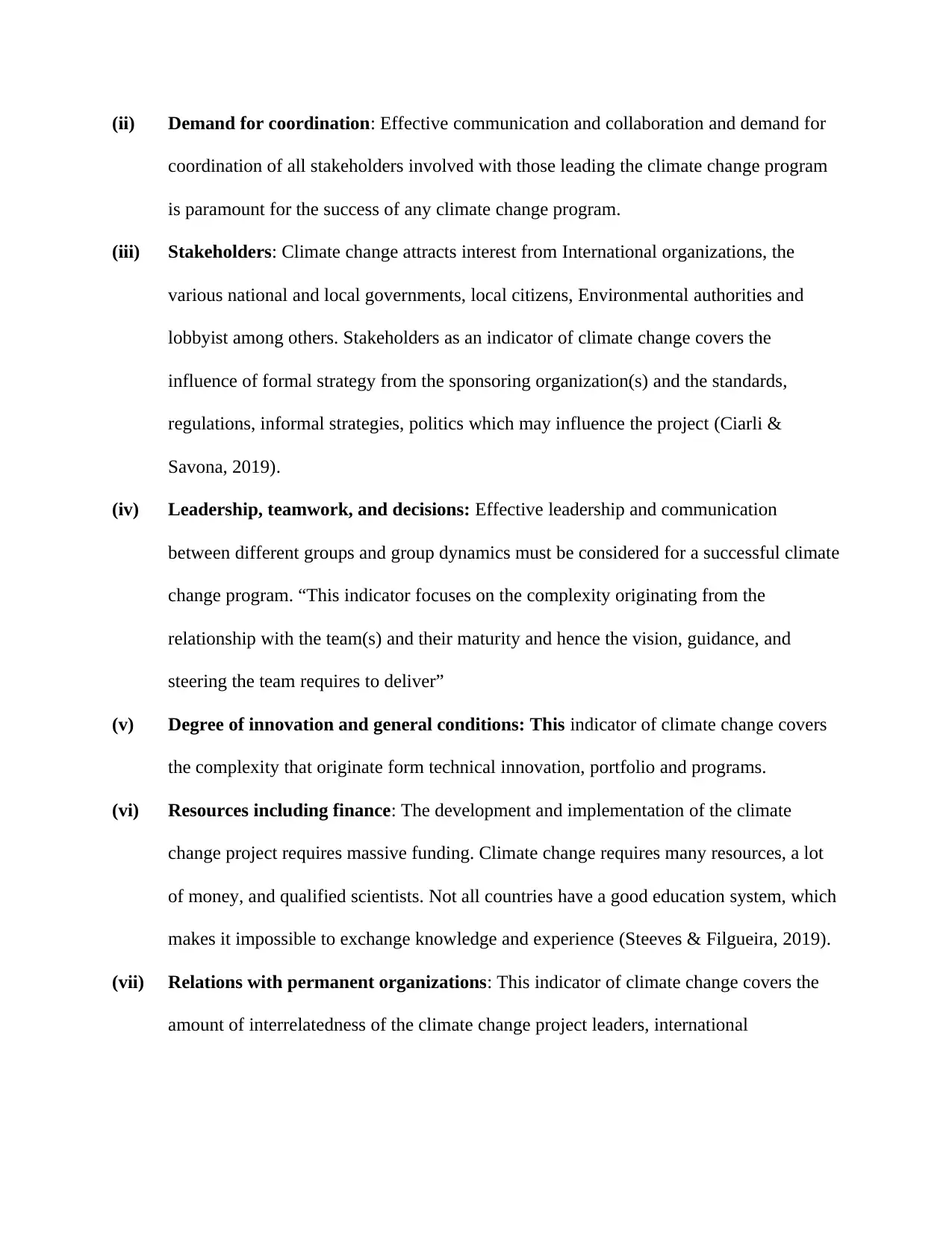
(ii) Demand for coordination: Effective communication and collaboration and demand for
coordination of all stakeholders involved with those leading the climate change program
is paramount for the success of any climate change program.
(iii) Stakeholders: Climate change attracts interest from International organizations, the
various national and local governments, local citizens, Environmental authorities and
lobbyist among others. Stakeholders as an indicator of climate change covers the
influence of formal strategy from the sponsoring organization(s) and the standards,
regulations, informal strategies, politics which may influence the project (Ciarli &
Savona, 2019).
(iv) Leadership, teamwork, and decisions: Effective leadership and communication
between different groups and group dynamics must be considered for a successful climate
change program. “This indicator focuses on the complexity originating from the
relationship with the team(s) and their maturity and hence the vision, guidance, and
steering the team requires to deliver”
(v) Degree of innovation and general conditions: This indicator of climate change covers
the complexity that originate form technical innovation, portfolio and programs.
(vi) Resources including finance: The development and implementation of the climate
change project requires massive funding. Climate change requires many resources, a lot
of money, and qualified scientists. Not all countries have a good education system, which
makes it impossible to exchange knowledge and experience (Steeves & Filgueira, 2019).
(vii) Relations with permanent organizations: This indicator of climate change covers the
amount of interrelatedness of the climate change project leaders, international
coordination of all stakeholders involved with those leading the climate change program
is paramount for the success of any climate change program.
(iii) Stakeholders: Climate change attracts interest from International organizations, the
various national and local governments, local citizens, Environmental authorities and
lobbyist among others. Stakeholders as an indicator of climate change covers the
influence of formal strategy from the sponsoring organization(s) and the standards,
regulations, informal strategies, politics which may influence the project (Ciarli &
Savona, 2019).
(iv) Leadership, teamwork, and decisions: Effective leadership and communication
between different groups and group dynamics must be considered for a successful climate
change program. “This indicator focuses on the complexity originating from the
relationship with the team(s) and their maturity and hence the vision, guidance, and
steering the team requires to deliver”
(v) Degree of innovation and general conditions: This indicator of climate change covers
the complexity that originate form technical innovation, portfolio and programs.
(vi) Resources including finance: The development and implementation of the climate
change project requires massive funding. Climate change requires many resources, a lot
of money, and qualified scientists. Not all countries have a good education system, which
makes it impossible to exchange knowledge and experience (Steeves & Filgueira, 2019).
(vii) Relations with permanent organizations: This indicator of climate change covers the
amount of interrelatedness of the climate change project leaders, international
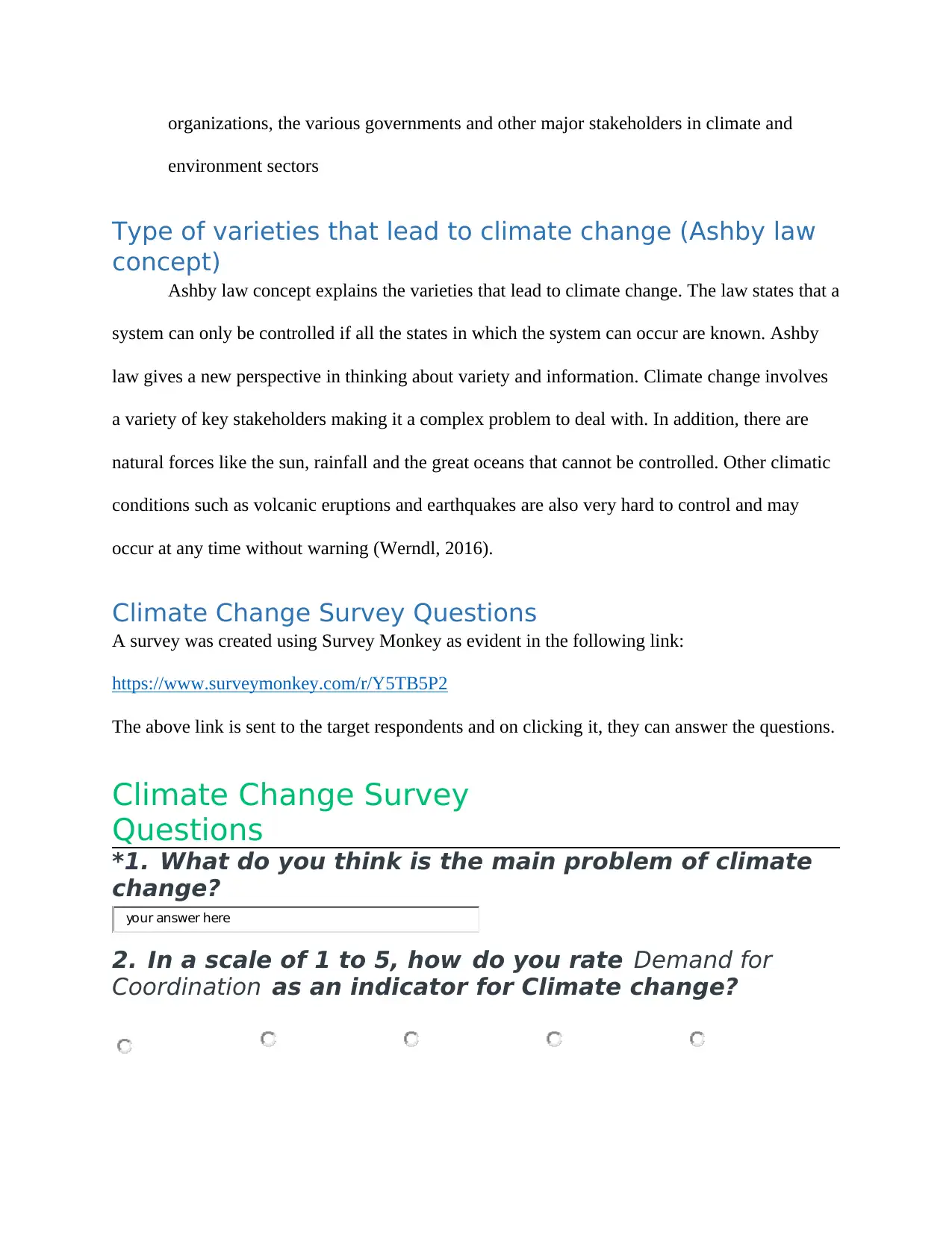
organizations, the various governments and other major stakeholders in climate and
environment sectors
Type of varieties that lead to climate change (Ashby law
concept)
Ashby law concept explains the varieties that lead to climate change. The law states that a
system can only be controlled if all the states in which the system can occur are known. Ashby
law gives a new perspective in thinking about variety and information. Climate change involves
a variety of key stakeholders making it a complex problem to deal with. In addition, there are
natural forces like the sun, rainfall and the great oceans that cannot be controlled. Other climatic
conditions such as volcanic eruptions and earthquakes are also very hard to control and may
occur at any time without warning (Werndl, 2016).
Climate Change Survey Questions
A survey was created using Survey Monkey as evident in the following link:
https://www.surveymonkey.com/r/Y5TB5P2
The above link is sent to the target respondents and on clicking it, they can answer the questions.
Climate Change Survey
Questions
*1. What do you think is the main problem of climate
change?
2. In a scale of 1 to 5, how do you rate Demand for
Coordination as an indicator for Climate change?
your answer here
environment sectors
Type of varieties that lead to climate change (Ashby law
concept)
Ashby law concept explains the varieties that lead to climate change. The law states that a
system can only be controlled if all the states in which the system can occur are known. Ashby
law gives a new perspective in thinking about variety and information. Climate change involves
a variety of key stakeholders making it a complex problem to deal with. In addition, there are
natural forces like the sun, rainfall and the great oceans that cannot be controlled. Other climatic
conditions such as volcanic eruptions and earthquakes are also very hard to control and may
occur at any time without warning (Werndl, 2016).
Climate Change Survey Questions
A survey was created using Survey Monkey as evident in the following link:
https://www.surveymonkey.com/r/Y5TB5P2
The above link is sent to the target respondents and on clicking it, they can answer the questions.
Climate Change Survey
Questions
*1. What do you think is the main problem of climate
change?
2. In a scale of 1 to 5, how do you rate Demand for
Coordination as an indicator for Climate change?
your answer here
⊘ This is a preview!⊘
Do you want full access?
Subscribe today to unlock all pages.

Trusted by 1+ million students worldwide
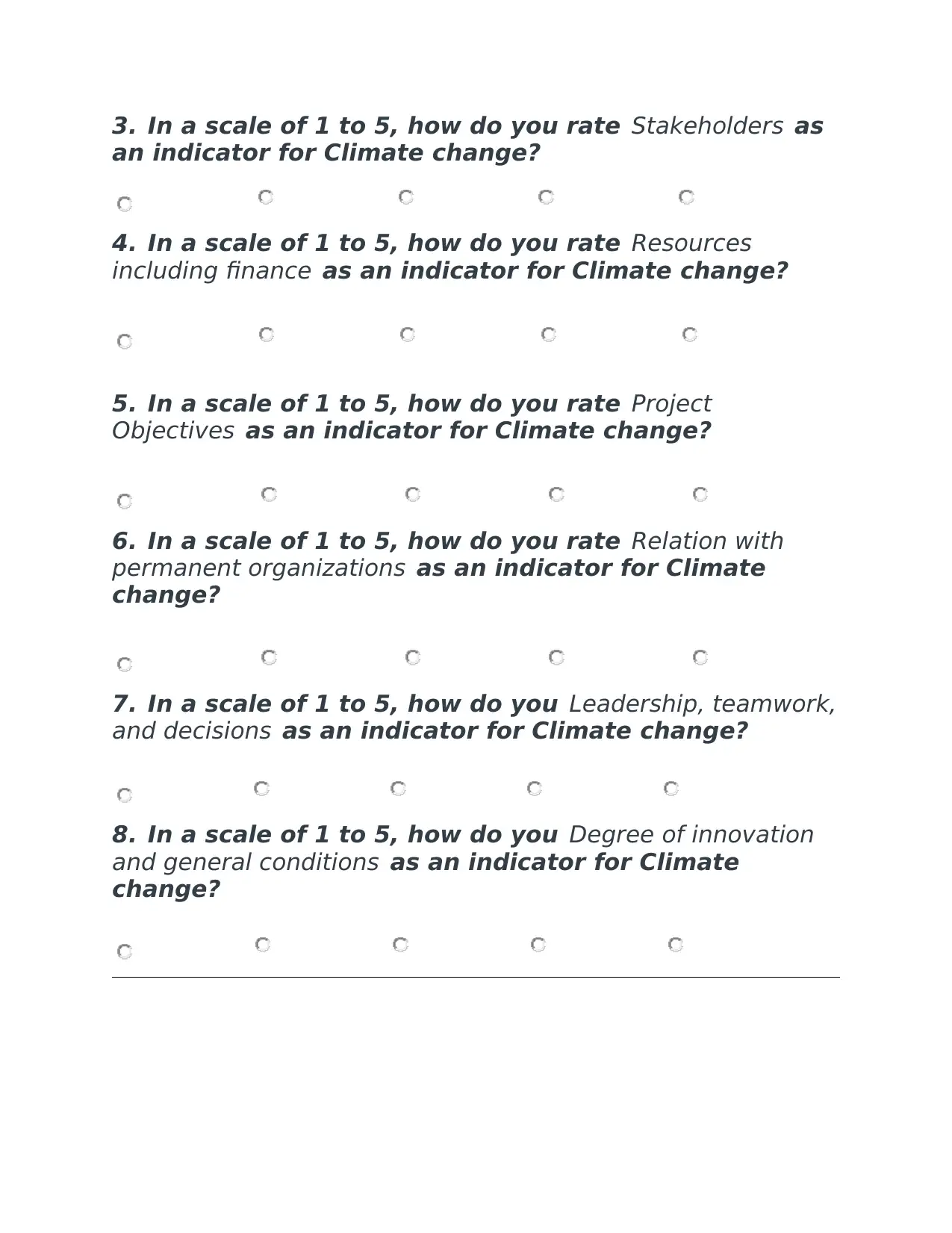
3. In a scale of 1 to 5, how do you rate Stakeholders as
an indicator for Climate change?
4. In a scale of 1 to 5, how do you rate Resources
including finance as an indicator for Climate change?
5. In a scale of 1 to 5, how do you rate Project
Objectives as an indicator for Climate change?
6. In a scale of 1 to 5, how do you rate Relation with
permanent organizations as an indicator for Climate
change?
7. In a scale of 1 to 5, how do you Leadership, teamwork,
and decisions as an indicator for Climate change?
8. In a scale of 1 to 5, how do you Degree of innovation
and general conditions as an indicator for Climate
change?
an indicator for Climate change?
4. In a scale of 1 to 5, how do you rate Resources
including finance as an indicator for Climate change?
5. In a scale of 1 to 5, how do you rate Project
Objectives as an indicator for Climate change?
6. In a scale of 1 to 5, how do you rate Relation with
permanent organizations as an indicator for Climate
change?
7. In a scale of 1 to 5, how do you Leadership, teamwork,
and decisions as an indicator for Climate change?
8. In a scale of 1 to 5, how do you Degree of innovation
and general conditions as an indicator for Climate
change?
Paraphrase This Document
Need a fresh take? Get an instant paraphrase of this document with our AI Paraphraser
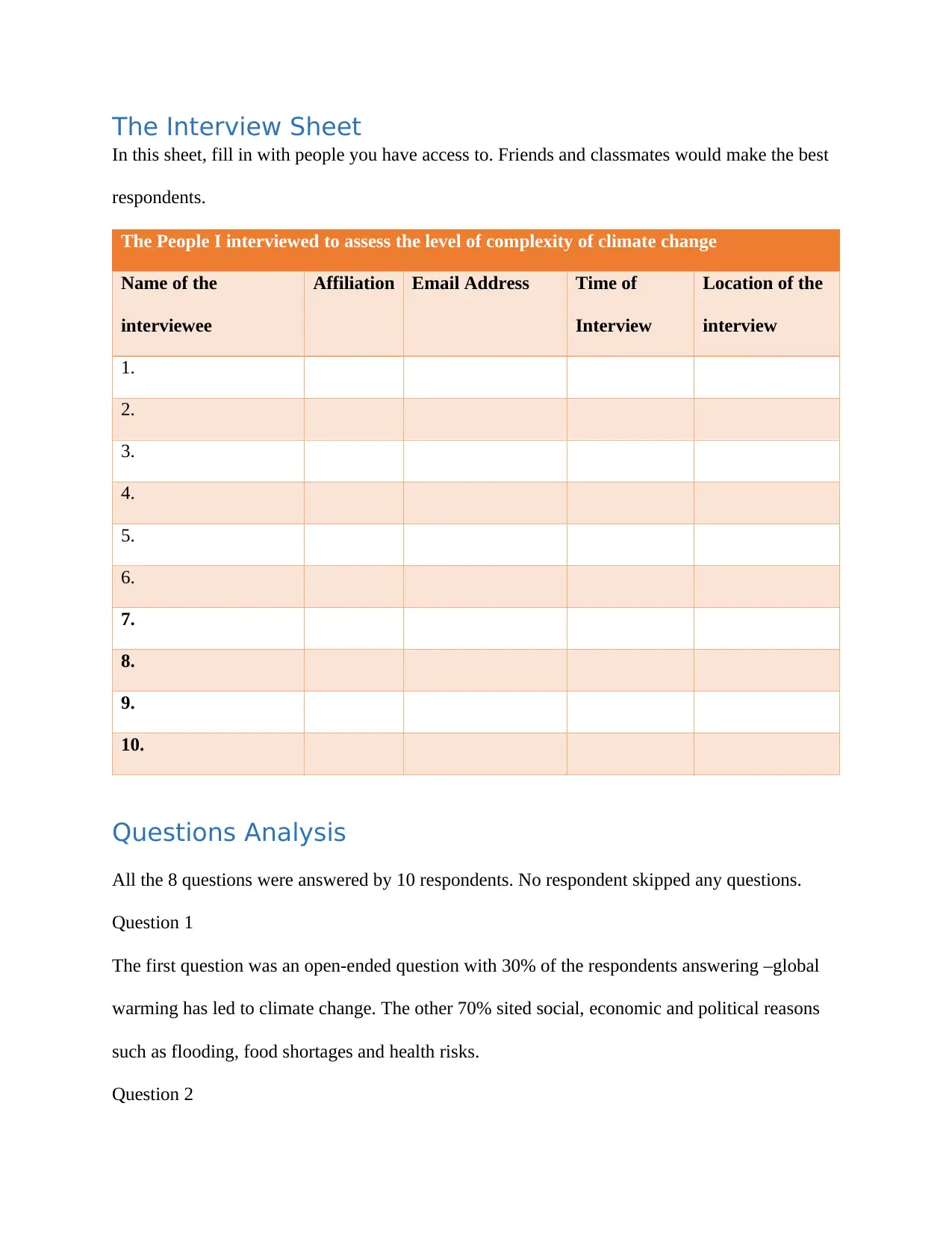
The Interview Sheet
In this sheet, fill in with people you have access to. Friends and classmates would make the best
respondents.
The People I interviewed to assess the level of complexity of climate change
Name of the
interviewee
Affiliation Email Address Time of
Interview
Location of the
interview
1.
2.
3.
4.
5.
6.
7.
8.
9.
10.
Questions Analysis
All the 8 questions were answered by 10 respondents. No respondent skipped any questions.
Question 1
The first question was an open-ended question with 30% of the respondents answering –global
warming has led to climate change. The other 70% sited social, economic and political reasons
such as flooding, food shortages and health risks.
Question 2
In this sheet, fill in with people you have access to. Friends and classmates would make the best
respondents.
The People I interviewed to assess the level of complexity of climate change
Name of the
interviewee
Affiliation Email Address Time of
Interview
Location of the
interview
1.
2.
3.
4.
5.
6.
7.
8.
9.
10.
Questions Analysis
All the 8 questions were answered by 10 respondents. No respondent skipped any questions.
Question 1
The first question was an open-ended question with 30% of the respondents answering –global
warming has led to climate change. The other 70% sited social, economic and political reasons
such as flooding, food shortages and health risks.
Question 2
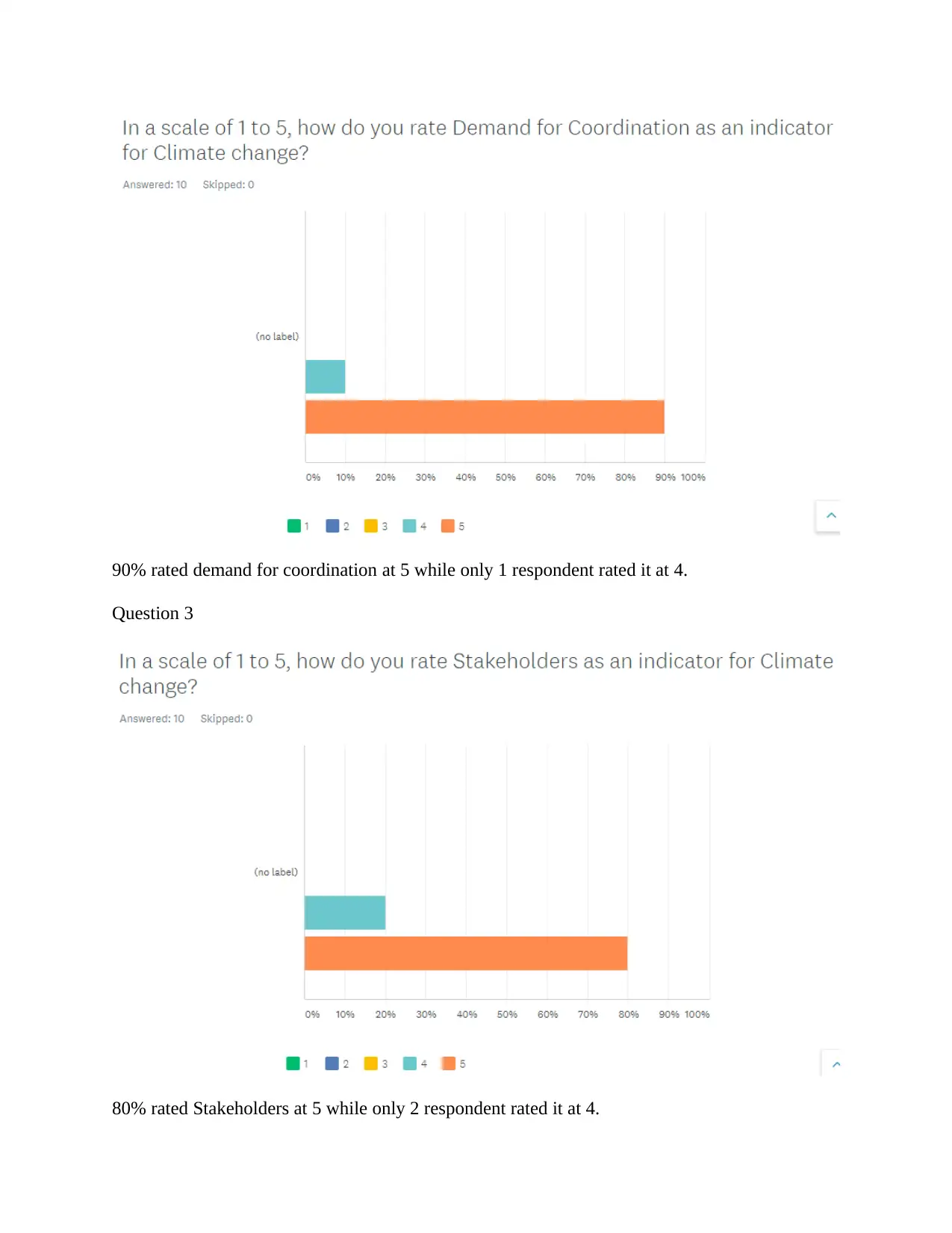
90% rated demand for coordination at 5 while only 1 respondent rated it at 4.
Question 3
80% rated Stakeholders at 5 while only 2 respondent rated it at 4.
Question 3
80% rated Stakeholders at 5 while only 2 respondent rated it at 4.
⊘ This is a preview!⊘
Do you want full access?
Subscribe today to unlock all pages.

Trusted by 1+ million students worldwide
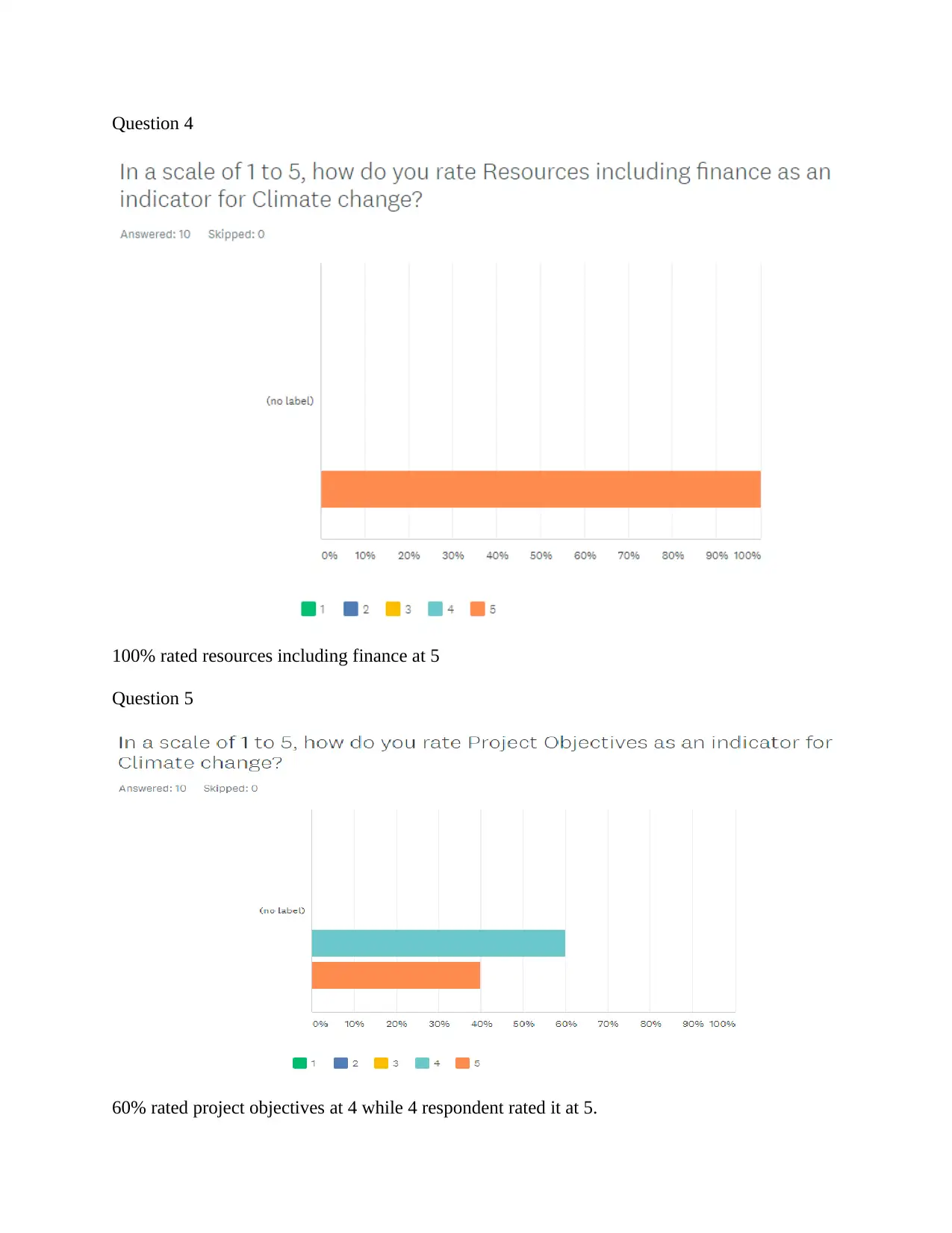
Question 4
100% rated resources including finance at 5
Question 5
60% rated project objectives at 4 while 4 respondent rated it at 5.
100% rated resources including finance at 5
Question 5
60% rated project objectives at 4 while 4 respondent rated it at 5.
Paraphrase This Document
Need a fresh take? Get an instant paraphrase of this document with our AI Paraphraser
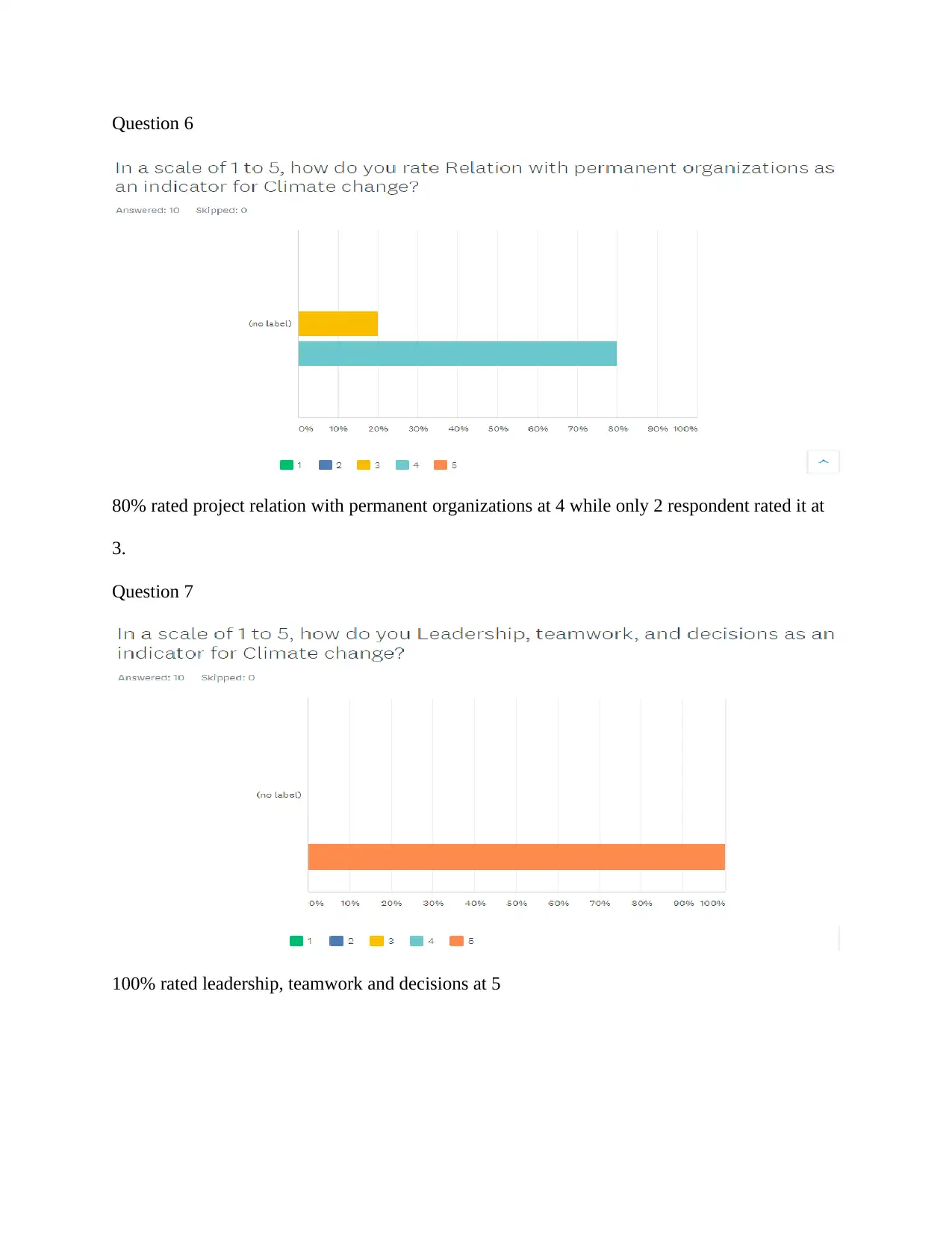
Question 6
80% rated project relation with permanent organizations at 4 while only 2 respondent rated it at
3.
Question 7
100% rated leadership, teamwork and decisions at 5
80% rated project relation with permanent organizations at 4 while only 2 respondent rated it at
3.
Question 7
100% rated leadership, teamwork and decisions at 5
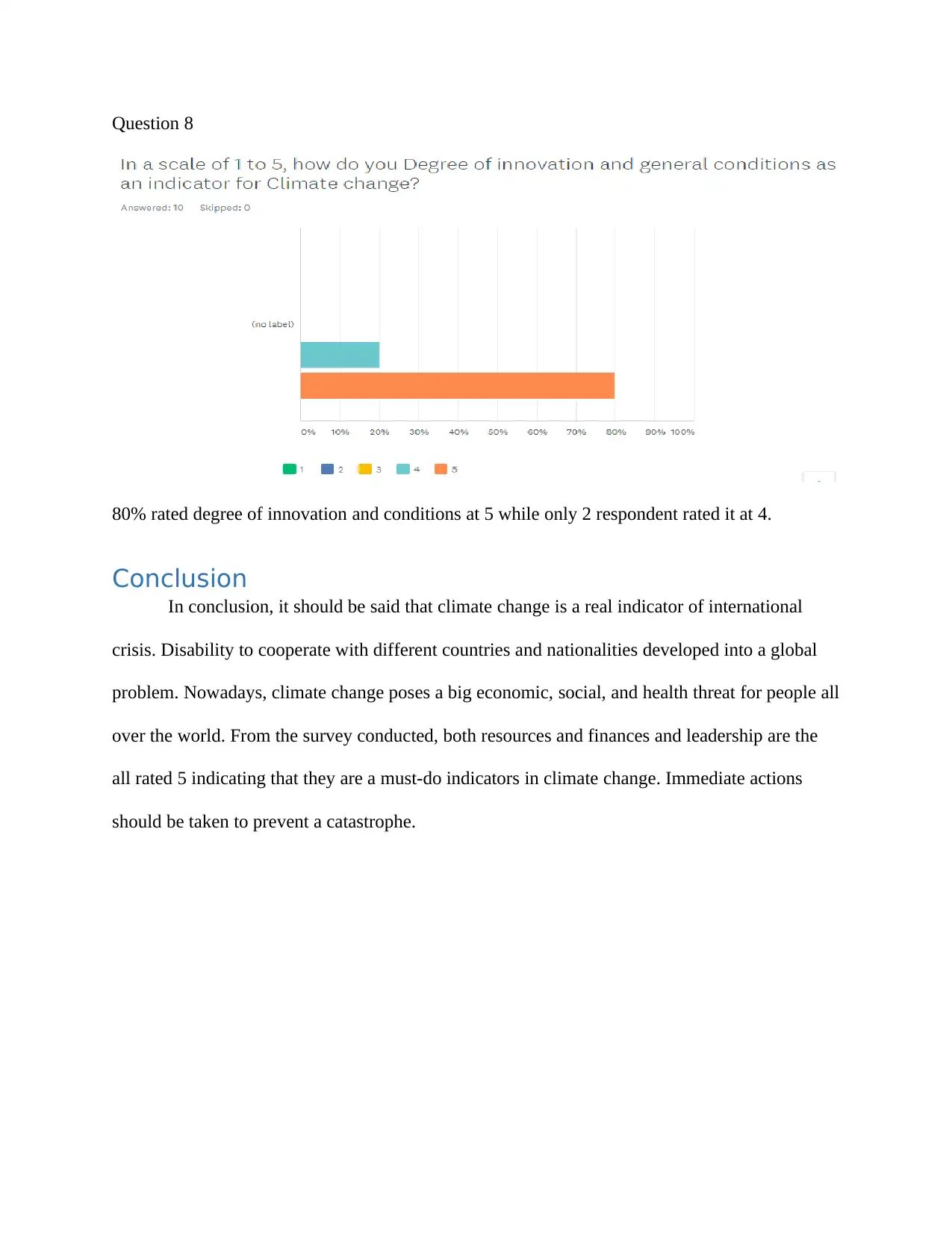
Question 8
80% rated degree of innovation and conditions at 5 while only 2 respondent rated it at 4.
Conclusion
In conclusion, it should be said that climate change is a real indicator of international
crisis. Disability to cooperate with different countries and nationalities developed into a global
problem. Nowadays, climate change poses a big economic, social, and health threat for people all
over the world. From the survey conducted, both resources and finances and leadership are the
all rated 5 indicating that they are a must-do indicators in climate change. Immediate actions
should be taken to prevent a catastrophe.
80% rated degree of innovation and conditions at 5 while only 2 respondent rated it at 4.
Conclusion
In conclusion, it should be said that climate change is a real indicator of international
crisis. Disability to cooperate with different countries and nationalities developed into a global
problem. Nowadays, climate change poses a big economic, social, and health threat for people all
over the world. From the survey conducted, both resources and finances and leadership are the
all rated 5 indicating that they are a must-do indicators in climate change. Immediate actions
should be taken to prevent a catastrophe.
⊘ This is a preview!⊘
Do you want full access?
Subscribe today to unlock all pages.

Trusted by 1+ million students worldwide
1 out of 14
Your All-in-One AI-Powered Toolkit for Academic Success.
+13062052269
info@desklib.com
Available 24*7 on WhatsApp / Email
![[object Object]](/_next/static/media/star-bottom.7253800d.svg)
Unlock your academic potential
Copyright © 2020–2025 A2Z Services. All Rights Reserved. Developed and managed by ZUCOL.


